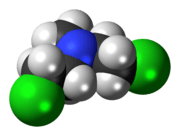Chlormethine
 | |
 | |
| Names | |
|---|---|
| IUPAC name
Bis(2-chloroethyl)methylamine | |
| Identifiers | |
| 51-75-2 | |
| ChEBI | CHEBI:28925 |
| ChEMBL | ChEMBL427 |
| ChemSpider | 3893 |
| DrugBank | DB00888 |
| EC Number | 200-120-5 |
| Jmol interactive 3D | Image |
| KEGG | D0767 |
| MeSH | Mechlorethamine |
| PubChem | 4033 |
| RTECS number | IA1750000 |
| UNII | 50D9XSG0VR |
| UN number | 2810 |
| |
| |
| Properties | |
| C5H11Cl2N | |
| Molar mass | 156.05 g·mol−1 |
| Appearance | Colourless liquid |
| Odor | Ichtyal, ammoniacal |
| log P | 0.91 |
| Pharmacology | |
| ATC code | D08 L01AA05 |
| Legal status |
|
| |
| |
| Pharmacokinetics: | |
| <1 minute | |
| 50% (renal) | |
| Related compounds | |
| Related amines |
|
| Related compounds |
|
| Except where otherwise noted, data are given for materials in their standard state (at 25 °C [77 °F], 100 kPa). | |
| | |
| Infobox references | |
Chlormethine (INN, BAN), mechlorethamine (widely used in the US, not the USAN, however) also known as mustine and HN2 and in former USSR known as Embichin is a nitrogen mustard sold under the brand name Mustargen. It is the prototype of alkylating agents, a group of anticancer chemotherapeutic drugs. It works by binding to DNA, crosslinking two strands and preventing cell duplication. It binds to the N7 nitrogen on the DNA base guanine. As the chemical is a blister agent, its use is strongly restricted within the Chemical Weapons Convention where it is classified as a Schedule 1 substance.
Mechlorethamine belongs to the group of nitrogen mustard alkylating agents.[1][2]
Uses
It has been derivatized into the estrogen analogue estramustine, used to treat prostate cancer. It can also be used in chemical warfare where it has the code-name HN2. This chemical is a form of nitrogen mustard gas and a powerful vesicant. Historically, some uses of mechlorethamine have included lymphoid malignancies such as Hodgkin’s disease, lymphosarcoma, chronic myelocytic leukemia, polycythemia vera, and bronchogenic carcinoma [3] Mechlorethamine is often administered intravenously,[4] but when compounded into a topical formulation it can also be used to treat skin diseases. There have been studies demonstrating that topical administration of mechlorethamine has efficacy in mycosis fungoides-type cutaneous T cell lymphoma [5][6][7]
Another important use of chlormethine is in the synthesis of meperidine (aka pethidine, demerol).
Side effects
Mechlorethamine is a highly toxic medication, especially for women who are pregnant, breastfeeding, or of childbearing age.[8][9]
The adverse effects of mechlorethamine depend on the formulation.[10] Adverse effect include:
“Hypersensitivity reactions, including anaphylaxis…. Nausea, vomiting and depression of formed elements in the circulating blood are dose-limiting side effects and usually occur with the use of full doses of MUSTARGEN. Jaundice, alopecia, vertigo, tinnitus and diminished hearing may occur infrequently. Rarely, hemolytic anemia associated with such diseases as the lymphomas and chronic lymphocytic leukemia may be precipitated by treatment with alkylating agents including MUSTARGEN. Also, various chromosomal abnormalities have been reported in association with nitrogen mustard therapy.”
History
Successful clinical use of chlormethine (mechlorethamine) resulted in development of the field of anticancer chemotherapy, led by Cornelius P. Rhoads at Memorial Sloan-Kettering. The drug is a nitrogen-based analogue of mustard gas (which is sulfur-based) and was derived from chemical warfare research. Secret clinical trials of the agent for Hodgkin's disease and several other lymphomas and leukemias in humans began in December 1942. Because of wartime secrecy restrictions, it was not until 1946 that the results of these trials were published openly.[11]
See also
References
- ↑ Rappeneau S, Baeza-Squiban A, Jeulin C, Marano F (March 2000). "Protection from cytotoxic effects induced by the nitrogen mustard mechlorethamine on human bronchial epithelial cells in vitro". Toxicol. Sci. 54 (1): 212–21. doi:10.1093/toxsci/54.1.212. PMID 10746948.
- ↑ Takimoto CH, Calvo E. "Principles of Oncologic Pharmacotherapy" in Pazdur R, Wagman LD, Camphausen KA, Hoskins WJ (Eds) Cancer Management: A Multidisciplinary Approach. 11 ed. 2008.
- ↑ Bunn P, Hoffman S, Norris D, Golitz L, Aeling J. Systemic therapy of cutaneous T-cell lymphoma (mycosis fungoides and the Sezary syndrome). Ann Intern Med. 1994; 121(8):592–602. [PubMed:8085692]
- ↑ Medline (2012). Mechlorethamine. Retrieved from http://www.nlm.nih.gov/medlineplus/druginfo/meds/a682223.html
- ↑ Lindahl LM, Fenger-Gron M, Iversen L. Topical nitrogen mustard therapy in patients with mycosis fungoides or parapsoriasis. J Eur Acad Dermatol Venereol. 2013 Feb;27(2):163-8.
- ↑ Galper SL, Smith BD, Wilson LD. Diagnosis and management of mycosis fungoides. Oncology (Williston Park). 2010 May;24(6):491-501.
- ↑ Lessin SR, Duvic M, Guitart J, Pandya AG, Strober BE, Olsen EA, Hull CM, Knobler EH, Rook AH, Kim EJ, Naylor MF, Adelson DM, Kimball AB, Wood GS, Sundram U, Wu H, Kim YH. Topical chemotherapy in cutaneous T-cell lymphoma: positive results of a randomized, controlled, multicenter trial testing the efficacy and safety of a novel mechlorethamine, 0.02%, gel in mycosis fungoides. JAMA Dermatol. 2013 Jan;149(1):25-32.
- ↑ Recordati Rare Diseases Inc. (2013). Mustargen Package Insert. Retrieved from http://www.drugs.com/pro/mustargen.html
- ↑ Actelion Pharmaceuticals Ltd. (2013) Valchlor Package Insert. Retrieved from http://www.accessdata.fda.gov/drugsatfda_docs/label/2013/202317lbl.pdf
- ↑ Mustargen and Valchlor
- ↑ Gilman A. (1963). "The initial clinical trial of nitrogen mustard". Am J Surg. 105 (5): 574–578. doi:10.1016/0002-9610(63)90232-0. PMID 13947966.
External links
| ||||||||||||||||||||||||||||||||||||||